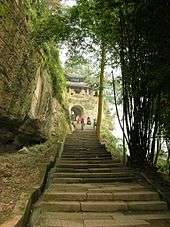Diaoyu Fortress

The Diaoyu Fortress or Diaoyucheng (simplified Chinese: 钓鱼城; traditional Chinese: 釣魚城; pinyin: Diàoyúchéng) is one of the great ancient battlefields of China, located on the Diaoyu Mountain in Heyang Town, Hechuan District, Chongqing.[1] It is famous for its resistance to the Mongol armies in the latter half of the Song Dynasty. One of the most notable events was the death of Mongol leader Möngke Khan near the city, which forced the immediate withdrawal of Mongol troops from Syria and East Asia and prevented the Mongolian Empire from expanding towards Africa.
Although the Mongols and the Southern Song were united in their fight to bring down the Jurchen Jin dynasty, their pact broke immediately afterwards, and the Mongols launched an aggressive war against the tenacious Southern Song that lasted for more than a third of the 13th century. In the period from 1243 to 1279, Diaoyu experienced more than two hundred military confrontations in a miracle of "persistent resistance" that endured for thirty-six years.
The ancient Diaoyu covers an area of 2.94 square kilometres. Situated on a hill surrounded by water on three sides, it is located about five kilometers east of Hechuan, Chongqing, near the confluence of the Qu, Fu and Jialing rivers. The terrain is precipitous yet beautiful. About 700 years ago, Yu Jian built a fortress here to resist the Mongols during the Southern Song Dynasty (1127–1279).
Though numbering more than ten thousand and led by the Great Khan Möngke himself, the Mongols were unable to take the tiny fortress. Yu Jian won many brilliant victories, culminating in the deaths of Mongke and his vanguard General Wang Tege. According to some sources, Möngke might have been wounded by a cannon blast at Diaoyu and eventually died on August 11, 1259 (although according to some accounts he died of accident or illness while campaigning). As it contains many historical sites—a naval wharf, drilling grounds, watch towers, and a fortification with built-in cannons—Diaoyu has been designated a major national cultural and historic site by China's State Council.
See also
- Diaoyucheng, a 2012 Chinese opera based on the historic battle
References
- ↑ "Fishing City". Meiya Travel. Retrieved 17 September 2014. External link in
|publisher=(help)
Coordinates: 30°0′35″N 106°19′25″E / 30.00972°N 106.32361°E

